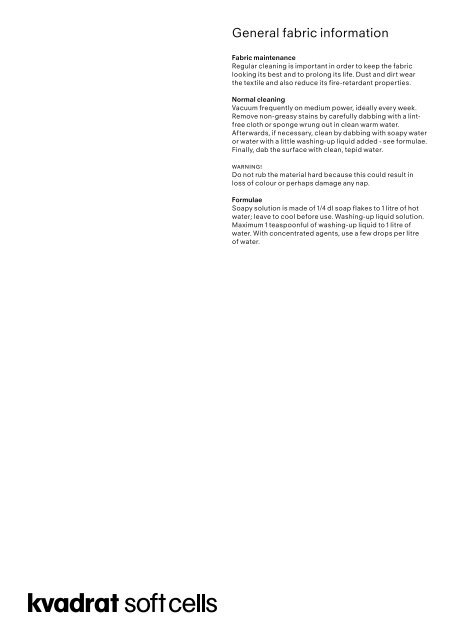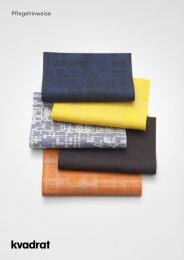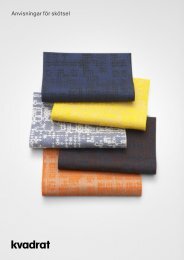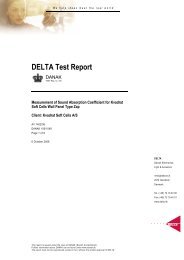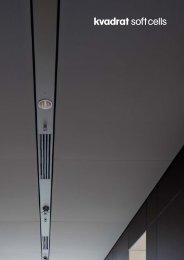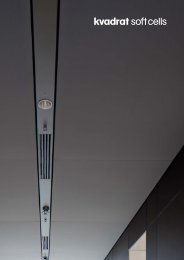You also want an ePaper? Increase the reach of your titles
YUMPU automatically turns print PDFs into web optimized ePapers that Google loves.
General fabric information<br />
Fabric maintenance<br />
Regular cleaning is important in order to keep the fabric<br />
looking its best and to prolong its life. Dust and dirt wear<br />
the textile and also reduce its fire-retardant properties.<br />
Normal cleaning<br />
Vacuum frequently on medium power, ideally every week.<br />
Remove non-greasy stains by <strong>care</strong>fully dabbing with a lintfree<br />
cloth or sponge wrung out in clean warm water.<br />
Afterwards, if necessary, clean by dabbing with soapy water<br />
or water with a little washing-up liquid added - see formulae.<br />
Finally, dab the surface with clean, tepid water.<br />
warning!<br />
Do not rub the material hard because this could result in<br />
loss of colour or perhaps damage any nap.<br />
Formulae<br />
Soapy solution is made of 1/4 dl soap flakes to 1 litre of hot<br />
water; leave to cool before use. Washing-up liquid solution.<br />
Maximum 1 teaspoonful of washing-up liquid to 1 litre of<br />
water. With concentrated agents, use a few drops per litre<br />
of water.
Wool maintenance<br />
Daily <strong>care</strong> and immediate stain removal will ensure that<br />
your wool fabric will keep looking good for many years to<br />
come. It is normally sufficient to regularly vacuum and air<br />
wool fabric.<br />
As a rule, many types of stains can be removed using warm<br />
water. If the stain does not disappear using water, then<br />
treat the stain according to the following guide.<br />
Stain removal<br />
If you act quickly, it is not difficult to remove a spill and<br />
avoid staining.<br />
First, soak up the liquid with an absorbent napkin or<br />
cloth. For dried stains use a spoon to roughen the surface.<br />
To avoid the stain spreading further start from the edge of<br />
the stain working towards the middle. Then, treat the stain<br />
according to the following guide.<br />
warning!<br />
Be <strong>care</strong>ful when using solvents, because these could<br />
dissolve the material behind.<br />
General information<br />
These tips are purely recommendations and cannot<br />
guarantee 100% stain removal. In all cases, we recommend<br />
contacting a professional cleaning establishment,<br />
particularly for bigger stains and for thorough cleaning.
Alcohol<br />
Treat using water mixed with furniture shampoo and<br />
a dash of spirit vinegar. Then, use diluted surgical spirit<br />
(1 part spirit to 5 parts water).<br />
Ballpoint pen<br />
Use surgical spirit, then acetone (e.g. oil-free nail varnish<br />
remover). Then, clean using 1 teaspoon of detergent in<br />
hot water.<br />
Blood<br />
Use cold water plus 1 teaspoon of table salt.<br />
Then, clean with water mixed with furniture shampoo.<br />
Coffee (black)<br />
Use diluted surgical spirit (1 part spirit to 5 parts water).<br />
Then, clean using water with furniture shampoo added.<br />
Cream<br />
Treat using water mixed with furniture shampoo.<br />
Then, use mineral or vegetable turpentine (or similar).<br />
Drinks based on fruit syrup<br />
Clean with water with furniture shampoo. Then, use<br />
surgical spirit with water mixed with furniture shampoo.<br />
Fizzy drinks<br />
Treat using water mixed with furniture shampoo adding<br />
a dash of spirit vinegar.<br />
Ink (writing)<br />
Treat using water mixed with furniture shampoo.<br />
Then, contact a specialist.<br />
Juice<br />
Treat using water mixed with furniture shampoo.<br />
Then, treat again by adding surgical spirit to the water<br />
and furniture shampoo.<br />
Milk<br />
Treat using cold water with 1 teaspoon of table salt.<br />
Then, clean with water with furniture shampoo added.<br />
Oil and grease<br />
Treat using a mineral or vegetable turpentine (or similar).<br />
Then, use a fat or oil stain remover. Finally, use water mixed<br />
with furniture shampoo.<br />
Paint (oil)<br />
Treat using a mineral or vegetable turpentine (or similar).<br />
Then, use water mixed with furniture shampoo. Finally,<br />
contact a specialist.<br />
Paint (water based)<br />
Start with just cold water. Then, use water mixed with<br />
furniture shampoo. Finally, contact a specialist.<br />
Shoe polish<br />
Treat using a mineral or vegetable turpentine (or similar).<br />
Then, use a fat or oil stain remover. Finally, use water mixed<br />
with furniture shampoo.<br />
Soot<br />
Vacuum thoroughly. Then, use water mixed with furniture<br />
shampoo. Finally, treat using a mineral or vegetable<br />
turpentine (or similar).<br />
Tea<br />
Treat using water mixed with furniture shampoo. Then,<br />
use diluted surgical spirit (1 part spirit to 5 parts water).<br />
Wine<br />
Treat using water mixed with furniture shampoo and a<br />
dash of spirit vinegar. Then, use diluted surgical spirit<br />
(1 part spirit to 5 parts water).
Trevira CS maintenance<br />
The permanence of the flame-retardance lies in the<br />
molecular structure of the fabric and is retained after<br />
washing or dry-cleaning. Stains can often be removed<br />
using a damp cloth before they penetrate into the fibres.<br />
Use of Trevira CS / synthetic textile<br />
Trevira CS is typically a hard-wearing and permanently<br />
non-flammable material and therefore suitable for many<br />
applications: offices, hotels, institutions, homes.<br />
Trevira CS / synthetic textile is not affected by rot or mould<br />
and is therefore suitable for moist environments such as<br />
swimming pools, spas, etc. It is also suitable for outdoor<br />
areas. Obviously, the textile will fade, which is unavoidable,<br />
but the material will not be destroyed by the elements, such<br />
as e.g. natural fibres. In terms of non-flammable properties,<br />
a distinction needs to be made between Trevira CS and<br />
other synthetic textiles, as Trevira CS is permanently<br />
non-flammable, while other synthetic articles, e.g. ordinary<br />
polyester articles and microfibres do not have similar<br />
non-flammable properties.<br />
Stain removal<br />
If the stain has dried, first scrape any excess off by hand or<br />
with a brush. Then vacuum the stain, followed by cleaning<br />
using water and afterwards, if needed, soapy water. It is<br />
important to rinse with clean water. Treating stubborn<br />
stains, stain removers should be “worked into the fabric”<br />
with a clean, damp, absorbent cloth.<br />
warning!<br />
Be <strong>care</strong>ful when using solvents, because these could<br />
dissolve the material behind.<br />
General information<br />
These tips are purely recommendations and cannot<br />
guarantee 100% stain removal. In all cases, we recommend<br />
contacting a professional cleaning establishment,<br />
particularly for bigger stains and for thorough cleaning.
Alcohol<br />
Fresh stains treat with a weak solution of organic acids<br />
(household vinegar). Rinse immediately.* Dried stains treat<br />
with a general “oxidative” bleaching agent.†<br />
Ballpoint pen<br />
Use surgical spirit, then acetone (e.g. oil-free nail<br />
varnish remover).<br />
Blood<br />
Fresh stains treat with an alkaline based cleaning agent<br />
e.g. soap flakes or washing-up liquid and soda.<br />
Rinse immediately.*<br />
Dried stains treat with an enzyme agent, for example<br />
washing powder; note the recommended reaction time.<br />
Dry <strong>care</strong>fully.<br />
Coffee (black)<br />
Fresh stains treat with a weak solution of organic acids<br />
(household vinegar). Rinse immediately.*<br />
Dried stains treat with a general “oxidative”<br />
bleaching agent.†<br />
Cream<br />
Fresh stains treat with an alkaline based cleaning agent<br />
e.g. soap flakes or washing-up liquid and soda.<br />
Rinse immediately.*<br />
Dried stains treat with an enzyme agent, for example<br />
washing powder; note the recommended reaction time.<br />
Dry <strong>care</strong>fully.<br />
Grease<br />
Treat with a solvent (benzene, xylol, acetone etc.),<br />
while scraping it off, beating it gently and vacuum when<br />
completely dry.<br />
Ink<br />
Treat using water mixed with furniture shampoo.<br />
Then, contact a specialist.<br />
Juice, drinks (fruit syrup base)<br />
Fresh stains treat with a weak solution of organic acids<br />
(household vinegar). Rinse immediately.*<br />
Dried stains treat with a general “oxidative” bleaching agent.†<br />
Milk<br />
Fresh stains treat with an alkaline based cleaning agent<br />
e.g. soap flakes or washing-up liquid and soda.<br />
Rinse immediately.*<br />
Dried stains treat with an enzyme agent, for example<br />
washing powder; note the recommended reaction time.<br />
Dry <strong>care</strong>fully.<br />
Oil<br />
Treat with a solvent (benzene, xylol, acetone etc.),<br />
while scraping it off, beating it gently and vacuum when<br />
completely dry.<br />
Paint (oil based)<br />
Treat with a solvent (benzene, xylol, acetone etc.),<br />
while scraping it off, beating it gently and vacuum when<br />
completely dry.<br />
Paint (water based)<br />
Start with just cold water. Then, use water mixed with<br />
furniture shampoo. Finally, contact a specialist.<br />
Shoe polish<br />
Treat with a solvent (benzene, xylol, acetone etc.),<br />
while scraping it off, beating it gently and vacuum when<br />
completely dry.<br />
Tea<br />
Fresh stains treat with a weak solution of organic acids<br />
(household vinegar). Rinse immediately.*<br />
Dried stains treat with a general “oxidative”<br />
bleaching agent.†<br />
Wine<br />
Fresh stains treat with a weak solution of organic acids<br />
(household vinegar). Rinse immediately.*<br />
Dried stains treat with a general “oxidative”<br />
bleaching agent.†<br />
Finishing<br />
*) We recommend that after every cleaning, you use sprayextraction,<br />
so that any edge marks / residual cleaning<br />
agents are removed.<br />
†) “Oxidative” bleaching agent. This refers to a weak,<br />
3% hydrogen peroxide solution.


